University HRM Report: E-Learning and Multimedia in Organizations
VerifiedAdded on 2022/09/09
|7
|1365
|32
Report
AI Summary
This report delves into the application of e-Learning, particularly through multimedia activities, within the realm of Human Resource Management (HRM). It begins by defining e-Learning and its evolution, emphasizing its role in modern organizations and the shift from traditional classroom models. The report highlights the advantages of e-Learning, such as cost and time savings, consistency, scalability, and personalization, while also addressing potential disadvantages like cognitive overload and lack of face-to-face interaction. It explores the various learning styles addressed by multimedia approaches and provides budgeting considerations, internal and external factors influencing implementation, and real-world examples of organizations successfully employing e-Learning. The conclusion underscores the significance of e-Learning in the digital era, emphasizing its impact on interactivity, learner-centric approaches, and the overall improvement of training and development in HRM, ultimately opening opportunities for employees.
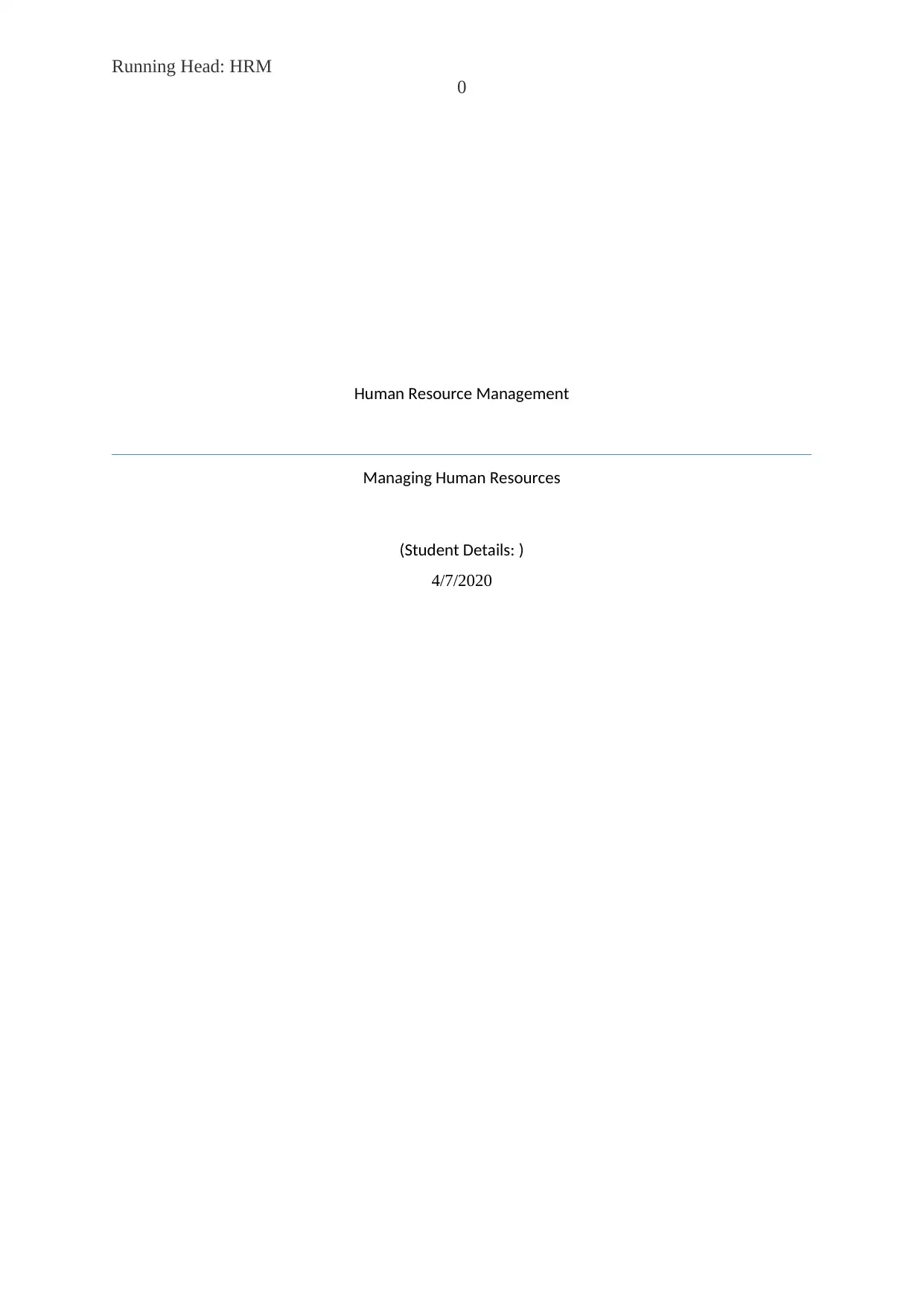
Running Head: HRM
0
Human Resource Management
Managing Human Resources
(Student Details: )
4/7/2020
0
Human Resource Management
Managing Human Resources
(Student Details: )
4/7/2020
Paraphrase This Document
Need a fresh take? Get an instant paraphrase of this document with our AI Paraphraser
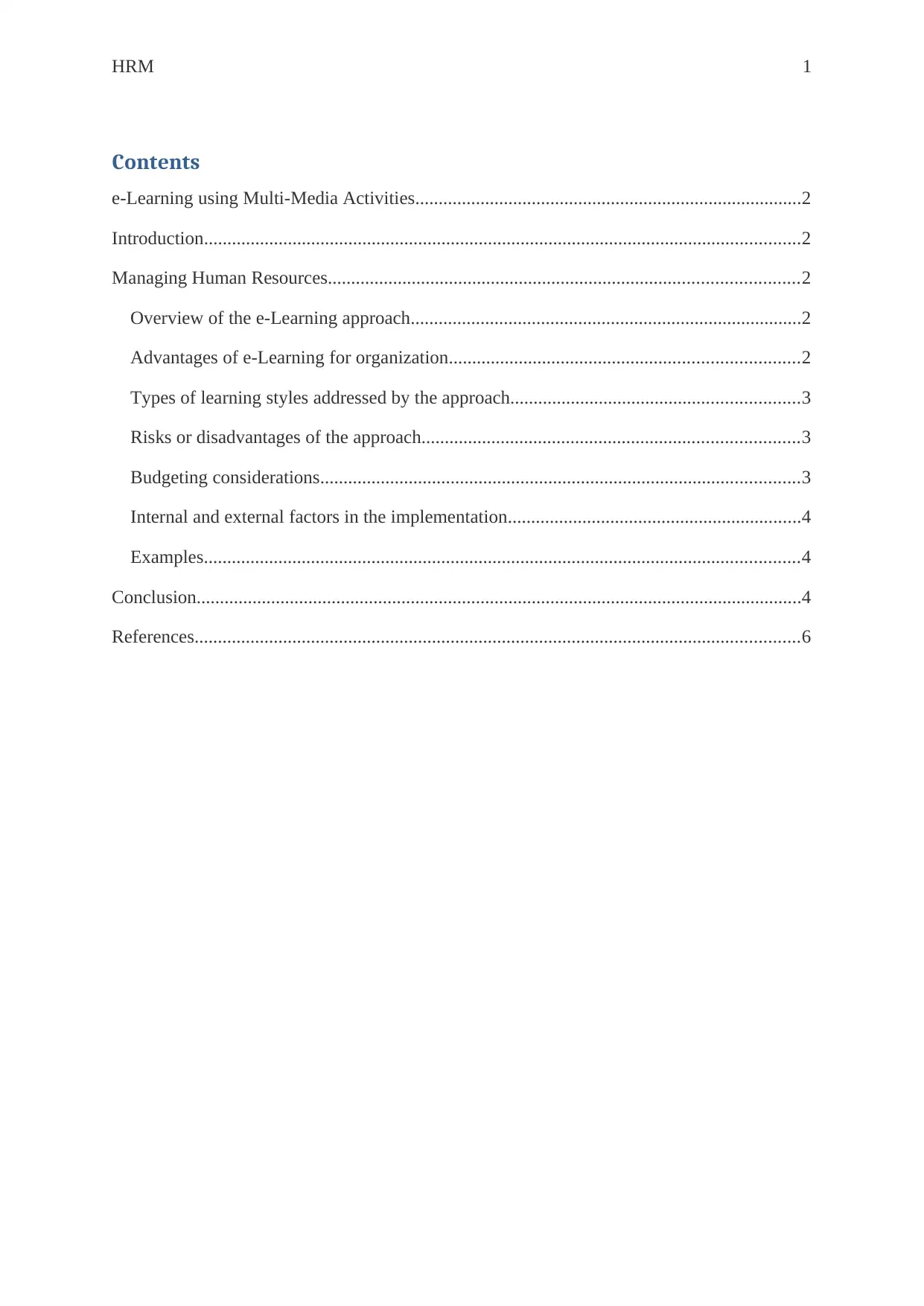
HRM 1
Contents
e-Learning using Multi-Media Activities...................................................................................2
Introduction................................................................................................................................2
Managing Human Resources.....................................................................................................2
Overview of the e-Learning approach....................................................................................2
Advantages of e-Learning for organization...........................................................................2
Types of learning styles addressed by the approach..............................................................3
Risks or disadvantages of the approach.................................................................................3
Budgeting considerations.......................................................................................................3
Internal and external factors in the implementation...............................................................4
Examples................................................................................................................................4
Conclusion..................................................................................................................................4
References..................................................................................................................................6
Contents
e-Learning using Multi-Media Activities...................................................................................2
Introduction................................................................................................................................2
Managing Human Resources.....................................................................................................2
Overview of the e-Learning approach....................................................................................2
Advantages of e-Learning for organization...........................................................................2
Types of learning styles addressed by the approach..............................................................3
Risks or disadvantages of the approach.................................................................................3
Budgeting considerations.......................................................................................................3
Internal and external factors in the implementation...............................................................4
Examples................................................................................................................................4
Conclusion..................................................................................................................................4
References..................................................................................................................................6
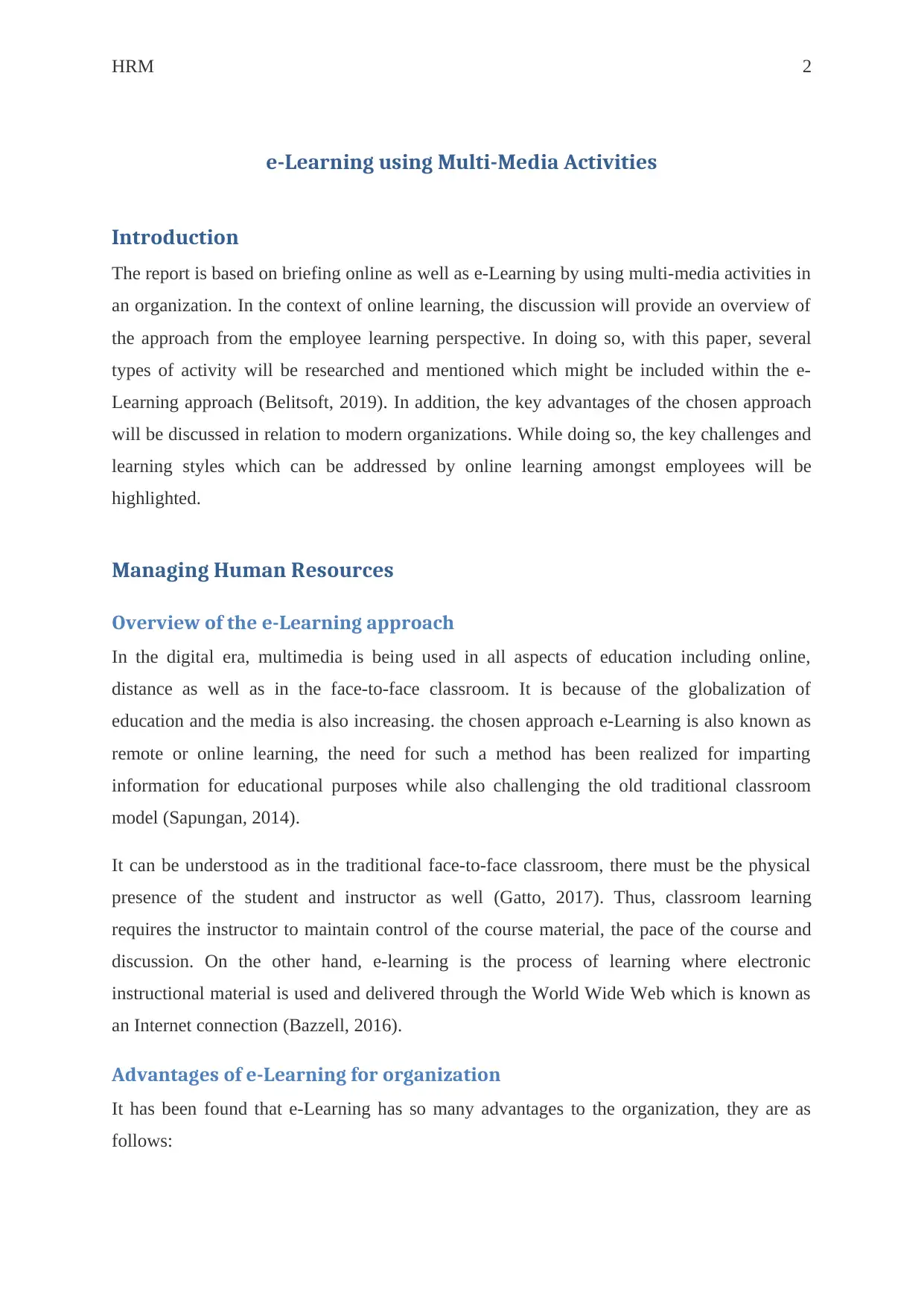
HRM 2
e-Learning using Multi-Media Activities
Introduction
The report is based on briefing online as well as e-Learning by using multi-media activities in
an organization. In the context of online learning, the discussion will provide an overview of
the approach from the employee learning perspective. In doing so, with this paper, several
types of activity will be researched and mentioned which might be included within the e-
Learning approach (Belitsoft, 2019). In addition, the key advantages of the chosen approach
will be discussed in relation to modern organizations. While doing so, the key challenges and
learning styles which can be addressed by online learning amongst employees will be
highlighted.
Managing Human Resources
Overview of the e-Learning approach
In the digital era, multimedia is being used in all aspects of education including online,
distance as well as in the face-to-face classroom. It is because of the globalization of
education and the media is also increasing. the chosen approach e-Learning is also known as
remote or online learning, the need for such a method has been realized for imparting
information for educational purposes while also challenging the old traditional classroom
model (Sapungan, 2014).
It can be understood as in the traditional face-to-face classroom, there must be the physical
presence of the student and instructor as well (Gatto, 2017). Thus, classroom learning
requires the instructor to maintain control of the course material, the pace of the course and
discussion. On the other hand, e-learning is the process of learning where electronic
instructional material is used and delivered through the World Wide Web which is known as
an Internet connection (Bazzell, 2016).
Advantages of e-Learning for organization
It has been found that e-Learning has so many advantages to the organization, they are as
follows:
e-Learning using Multi-Media Activities
Introduction
The report is based on briefing online as well as e-Learning by using multi-media activities in
an organization. In the context of online learning, the discussion will provide an overview of
the approach from the employee learning perspective. In doing so, with this paper, several
types of activity will be researched and mentioned which might be included within the e-
Learning approach (Belitsoft, 2019). In addition, the key advantages of the chosen approach
will be discussed in relation to modern organizations. While doing so, the key challenges and
learning styles which can be addressed by online learning amongst employees will be
highlighted.
Managing Human Resources
Overview of the e-Learning approach
In the digital era, multimedia is being used in all aspects of education including online,
distance as well as in the face-to-face classroom. It is because of the globalization of
education and the media is also increasing. the chosen approach e-Learning is also known as
remote or online learning, the need for such a method has been realized for imparting
information for educational purposes while also challenging the old traditional classroom
model (Sapungan, 2014).
It can be understood as in the traditional face-to-face classroom, there must be the physical
presence of the student and instructor as well (Gatto, 2017). Thus, classroom learning
requires the instructor to maintain control of the course material, the pace of the course and
discussion. On the other hand, e-learning is the process of learning where electronic
instructional material is used and delivered through the World Wide Web which is known as
an Internet connection (Bazzell, 2016).
Advantages of e-Learning for organization
It has been found that e-Learning has so many advantages to the organization, they are as
follows:
⊘ This is a preview!⊘
Do you want full access?
Subscribe today to unlock all pages.

Trusted by 1+ million students worldwide
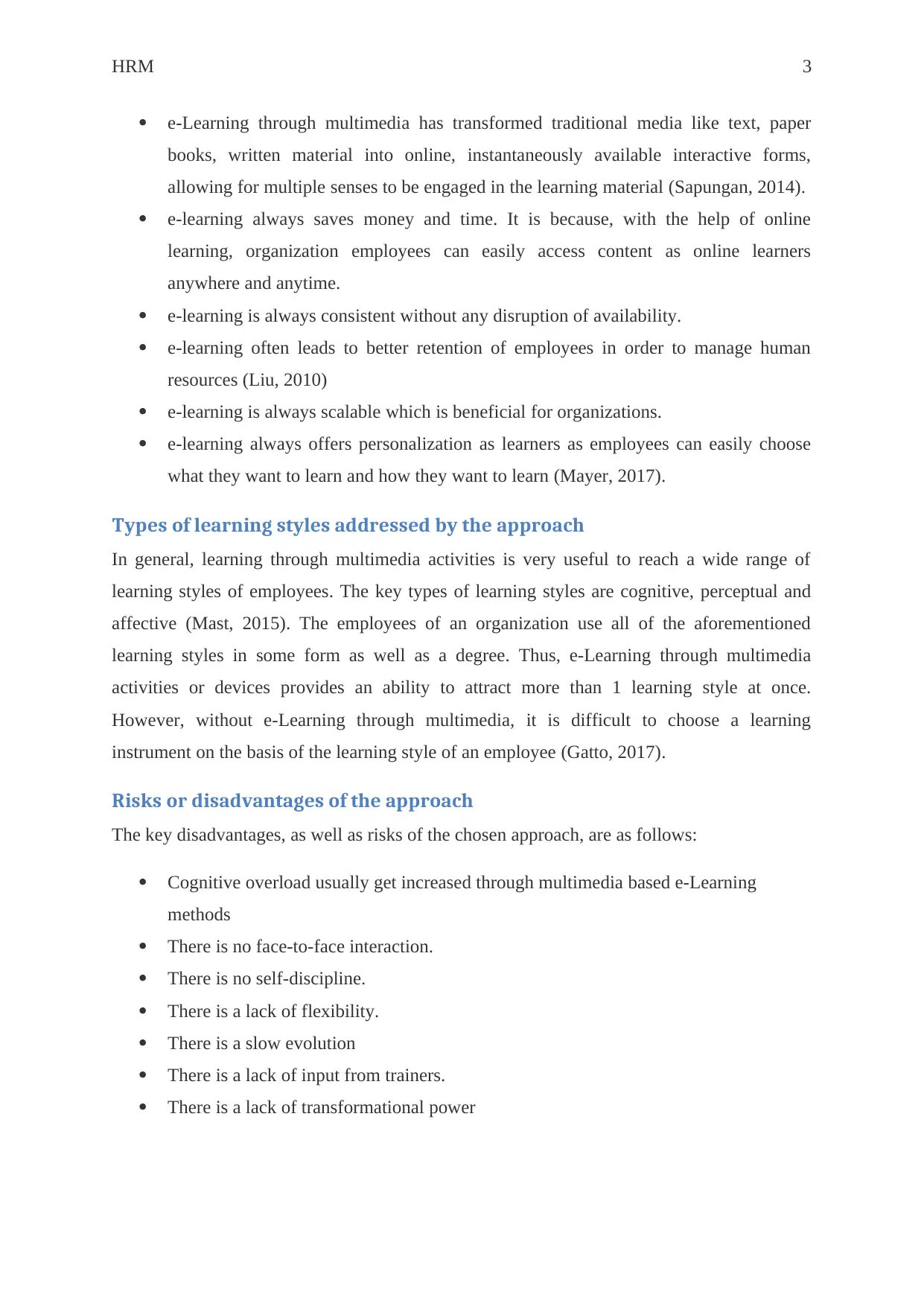
HRM 3
e-Learning through multimedia has transformed traditional media like text, paper
books, written material into online, instantaneously available interactive forms,
allowing for multiple senses to be engaged in the learning material (Sapungan, 2014).
e-learning always saves money and time. It is because, with the help of online
learning, organization employees can easily access content as online learners
anywhere and anytime.
e-learning is always consistent without any disruption of availability.
e-learning often leads to better retention of employees in order to manage human
resources (Liu, 2010)
e-learning is always scalable which is beneficial for organizations.
e-learning always offers personalization as learners as employees can easily choose
what they want to learn and how they want to learn (Mayer, 2017).
Types of learning styles addressed by the approach
In general, learning through multimedia activities is very useful to reach a wide range of
learning styles of employees. The key types of learning styles are cognitive, perceptual and
affective (Mast, 2015). The employees of an organization use all of the aforementioned
learning styles in some form as well as a degree. Thus, e-Learning through multimedia
activities or devices provides an ability to attract more than 1 learning style at once.
However, without e-Learning through multimedia, it is difficult to choose a learning
instrument on the basis of the learning style of an employee (Gatto, 2017).
Risks or disadvantages of the approach
The key disadvantages, as well as risks of the chosen approach, are as follows:
Cognitive overload usually get increased through multimedia based e-Learning
methods
There is no face-to-face interaction.
There is no self-discipline.
There is a lack of flexibility.
There is a slow evolution
There is a lack of input from trainers.
There is a lack of transformational power
e-Learning through multimedia has transformed traditional media like text, paper
books, written material into online, instantaneously available interactive forms,
allowing for multiple senses to be engaged in the learning material (Sapungan, 2014).
e-learning always saves money and time. It is because, with the help of online
learning, organization employees can easily access content as online learners
anywhere and anytime.
e-learning is always consistent without any disruption of availability.
e-learning often leads to better retention of employees in order to manage human
resources (Liu, 2010)
e-learning is always scalable which is beneficial for organizations.
e-learning always offers personalization as learners as employees can easily choose
what they want to learn and how they want to learn (Mayer, 2017).
Types of learning styles addressed by the approach
In general, learning through multimedia activities is very useful to reach a wide range of
learning styles of employees. The key types of learning styles are cognitive, perceptual and
affective (Mast, 2015). The employees of an organization use all of the aforementioned
learning styles in some form as well as a degree. Thus, e-Learning through multimedia
activities or devices provides an ability to attract more than 1 learning style at once.
However, without e-Learning through multimedia, it is difficult to choose a learning
instrument on the basis of the learning style of an employee (Gatto, 2017).
Risks or disadvantages of the approach
The key disadvantages, as well as risks of the chosen approach, are as follows:
Cognitive overload usually get increased through multimedia based e-Learning
methods
There is no face-to-face interaction.
There is no self-discipline.
There is a lack of flexibility.
There is a slow evolution
There is a lack of input from trainers.
There is a lack of transformational power
Paraphrase This Document
Need a fresh take? Get an instant paraphrase of this document with our AI Paraphraser
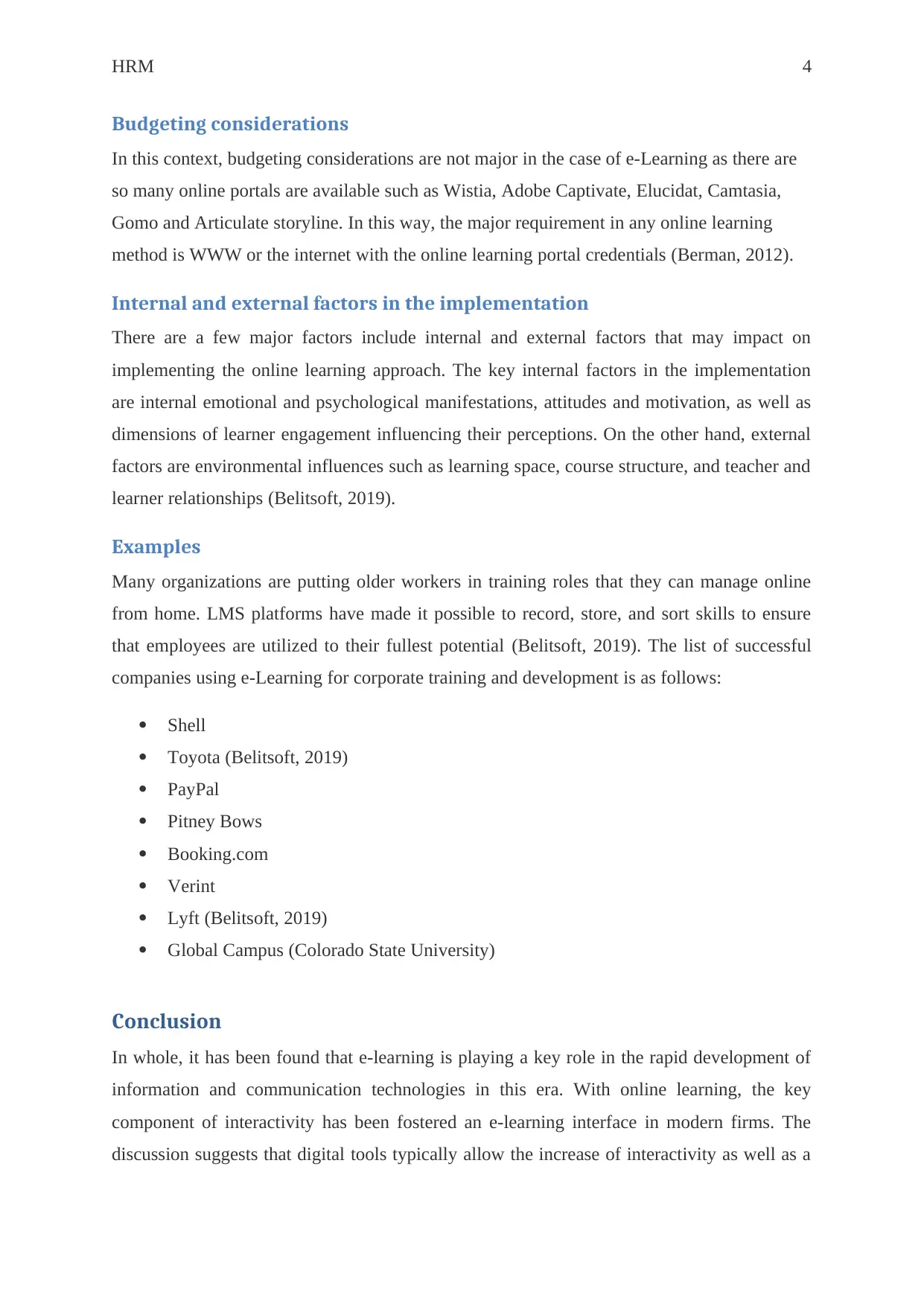
HRM 4
Budgeting considerations
In this context, budgeting considerations are not major in the case of e-Learning as there are
so many online portals are available such as Wistia, Adobe Captivate, Elucidat, Camtasia,
Gomo and Articulate storyline. In this way, the major requirement in any online learning
method is WWW or the internet with the online learning portal credentials (Berman, 2012).
Internal and external factors in the implementation
There are a few major factors include internal and external factors that may impact on
implementing the online learning approach. The key internal factors in the implementation
are internal emotional and psychological manifestations, attitudes and motivation, as well as
dimensions of learner engagement influencing their perceptions. On the other hand, external
factors are environmental influences such as learning space, course structure, and teacher and
learner relationships (Belitsoft, 2019).
Examples
Many organizations are putting older workers in training roles that they can manage online
from home. LMS platforms have made it possible to record, store, and sort skills to ensure
that employees are utilized to their fullest potential (Belitsoft, 2019). The list of successful
companies using e-Learning for corporate training and development is as follows:
Shell
Toyota (Belitsoft, 2019)
PayPal
Pitney Bows
Booking.com
Verint
Lyft (Belitsoft, 2019)
Global Campus (Colorado State University)
Conclusion
In whole, it has been found that e-learning is playing a key role in the rapid development of
information and communication technologies in this era. With online learning, the key
component of interactivity has been fostered an e-learning interface in modern firms. The
discussion suggests that digital tools typically allow the increase of interactivity as well as a
Budgeting considerations
In this context, budgeting considerations are not major in the case of e-Learning as there are
so many online portals are available such as Wistia, Adobe Captivate, Elucidat, Camtasia,
Gomo and Articulate storyline. In this way, the major requirement in any online learning
method is WWW or the internet with the online learning portal credentials (Berman, 2012).
Internal and external factors in the implementation
There are a few major factors include internal and external factors that may impact on
implementing the online learning approach. The key internal factors in the implementation
are internal emotional and psychological manifestations, attitudes and motivation, as well as
dimensions of learner engagement influencing their perceptions. On the other hand, external
factors are environmental influences such as learning space, course structure, and teacher and
learner relationships (Belitsoft, 2019).
Examples
Many organizations are putting older workers in training roles that they can manage online
from home. LMS platforms have made it possible to record, store, and sort skills to ensure
that employees are utilized to their fullest potential (Belitsoft, 2019). The list of successful
companies using e-Learning for corporate training and development is as follows:
Shell
Toyota (Belitsoft, 2019)
PayPal
Pitney Bows
Booking.com
Verint
Lyft (Belitsoft, 2019)
Global Campus (Colorado State University)
Conclusion
In whole, it has been found that e-learning is playing a key role in the rapid development of
information and communication technologies in this era. With online learning, the key
component of interactivity has been fostered an e-learning interface in modern firms. The
discussion suggests that digital tools typically allow the increase of interactivity as well as a
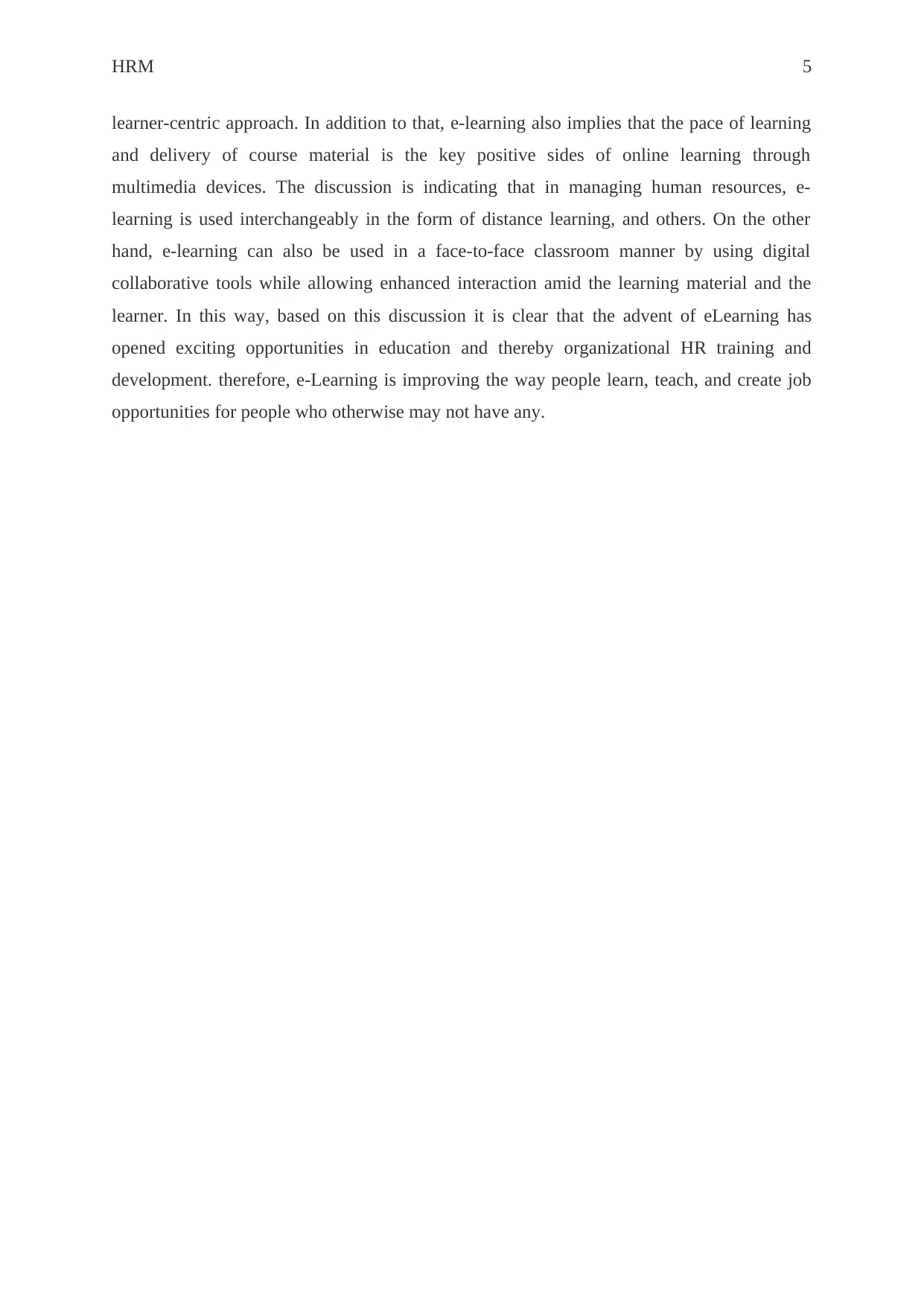
HRM 5
learner-centric approach. In addition to that, e-learning also implies that the pace of learning
and delivery of course material is the key positive sides of online learning through
multimedia devices. The discussion is indicating that in managing human resources, e-
learning is used interchangeably in the form of distance learning, and others. On the other
hand, e-learning can also be used in a face-to-face classroom manner by using digital
collaborative tools while allowing enhanced interaction amid the learning material and the
learner. In this way, based on this discussion it is clear that the advent of eLearning has
opened exciting opportunities in education and thereby organizational HR training and
development. therefore, e-Learning is improving the way people learn, teach, and create job
opportunities for people who otherwise may not have any.
learner-centric approach. In addition to that, e-learning also implies that the pace of learning
and delivery of course material is the key positive sides of online learning through
multimedia devices. The discussion is indicating that in managing human resources, e-
learning is used interchangeably in the form of distance learning, and others. On the other
hand, e-learning can also be used in a face-to-face classroom manner by using digital
collaborative tools while allowing enhanced interaction amid the learning material and the
learner. In this way, based on this discussion it is clear that the advent of eLearning has
opened exciting opportunities in education and thereby organizational HR training and
development. therefore, e-Learning is improving the way people learn, teach, and create job
opportunities for people who otherwise may not have any.
⊘ This is a preview!⊘
Do you want full access?
Subscribe today to unlock all pages.

Trusted by 1+ million students worldwide
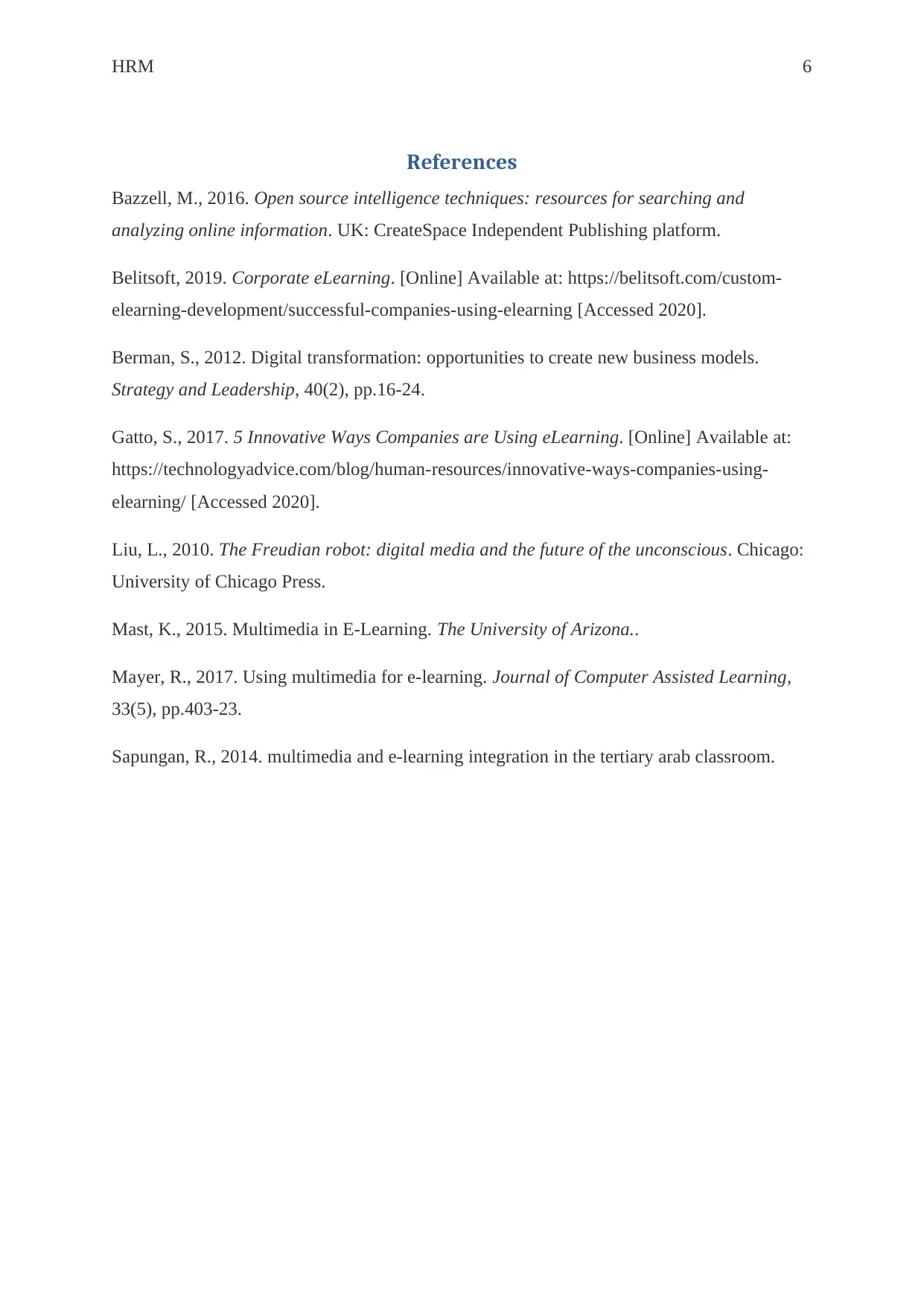
HRM 6
References
Bazzell, M., 2016. Open source intelligence techniques: resources for searching and
analyzing online information. UK: CreateSpace Independent Publishing platform.
Belitsoft, 2019. Corporate eLearning. [Online] Available at: https://belitsoft.com/custom-
elearning-development/successful-companies-using-elearning [Accessed 2020].
Berman, S., 2012. Digital transformation: opportunities to create new business models.
Strategy and Leadership, 40(2), pp.16-24.
Gatto, S., 2017. 5 Innovative Ways Companies are Using eLearning. [Online] Available at:
https://technologyadvice.com/blog/human-resources/innovative-ways-companies-using-
elearning/ [Accessed 2020].
Liu, L., 2010. The Freudian robot: digital media and the future of the unconscious. Chicago:
University of Chicago Press.
Mast, K., 2015. Multimedia in E-Learning. The University of Arizona..
Mayer, R., 2017. Using multimedia for e‐learning. Journal of Computer Assisted Learning,
33(5), pp.403-23.
Sapungan, R., 2014. multimedia and e-learning integration in the tertiary arab classroom.
References
Bazzell, M., 2016. Open source intelligence techniques: resources for searching and
analyzing online information. UK: CreateSpace Independent Publishing platform.
Belitsoft, 2019. Corporate eLearning. [Online] Available at: https://belitsoft.com/custom-
elearning-development/successful-companies-using-elearning [Accessed 2020].
Berman, S., 2012. Digital transformation: opportunities to create new business models.
Strategy and Leadership, 40(2), pp.16-24.
Gatto, S., 2017. 5 Innovative Ways Companies are Using eLearning. [Online] Available at:
https://technologyadvice.com/blog/human-resources/innovative-ways-companies-using-
elearning/ [Accessed 2020].
Liu, L., 2010. The Freudian robot: digital media and the future of the unconscious. Chicago:
University of Chicago Press.
Mast, K., 2015. Multimedia in E-Learning. The University of Arizona..
Mayer, R., 2017. Using multimedia for e‐learning. Journal of Computer Assisted Learning,
33(5), pp.403-23.
Sapungan, R., 2014. multimedia and e-learning integration in the tertiary arab classroom.
1 out of 7
Related Documents
Your All-in-One AI-Powered Toolkit for Academic Success.
+13062052269
info@desklib.com
Available 24*7 on WhatsApp / Email
![[object Object]](/_next/static/media/star-bottom.7253800d.svg)
Unlock your academic potential
Copyright © 2020–2025 A2Z Services. All Rights Reserved. Developed and managed by ZUCOL.





